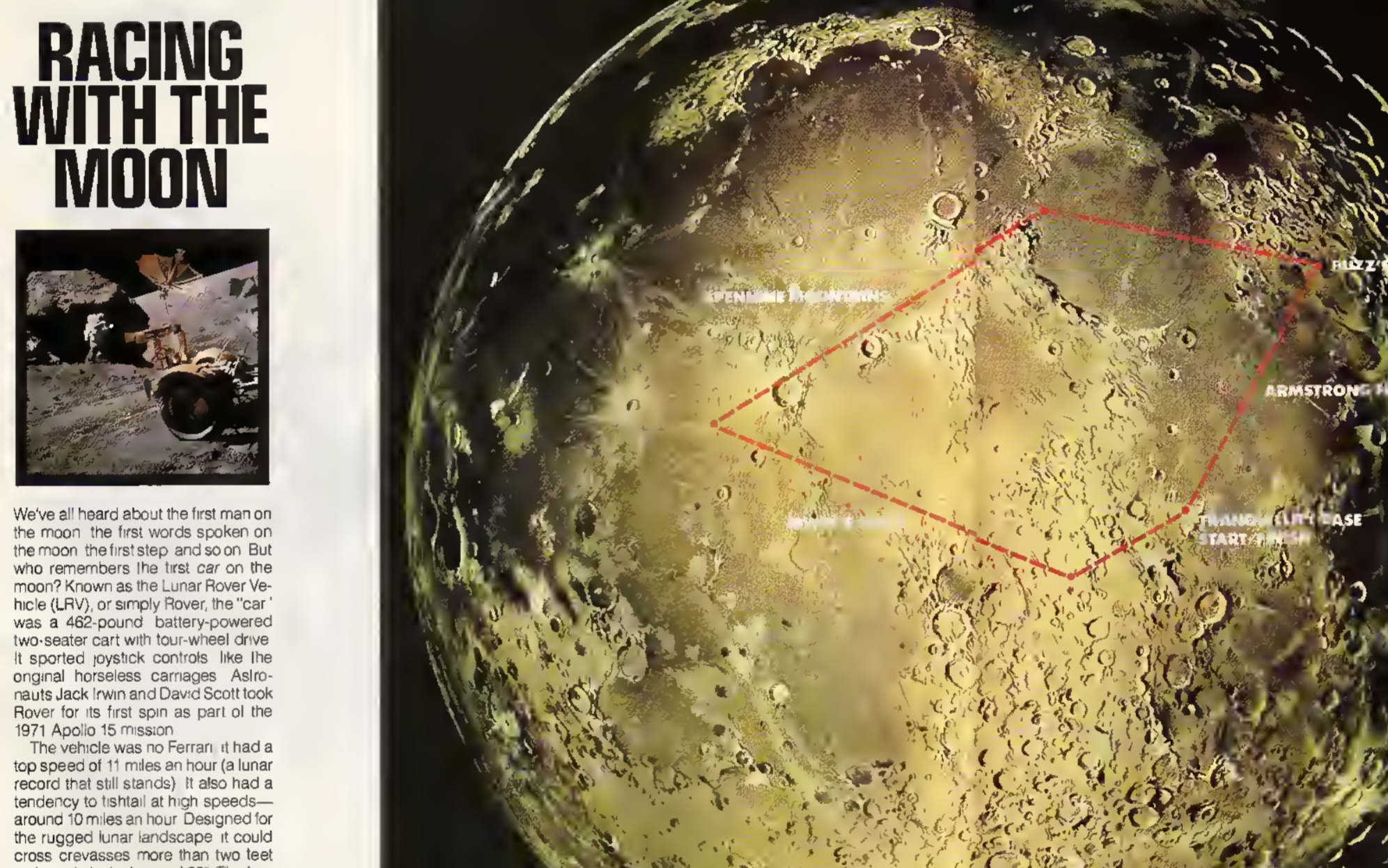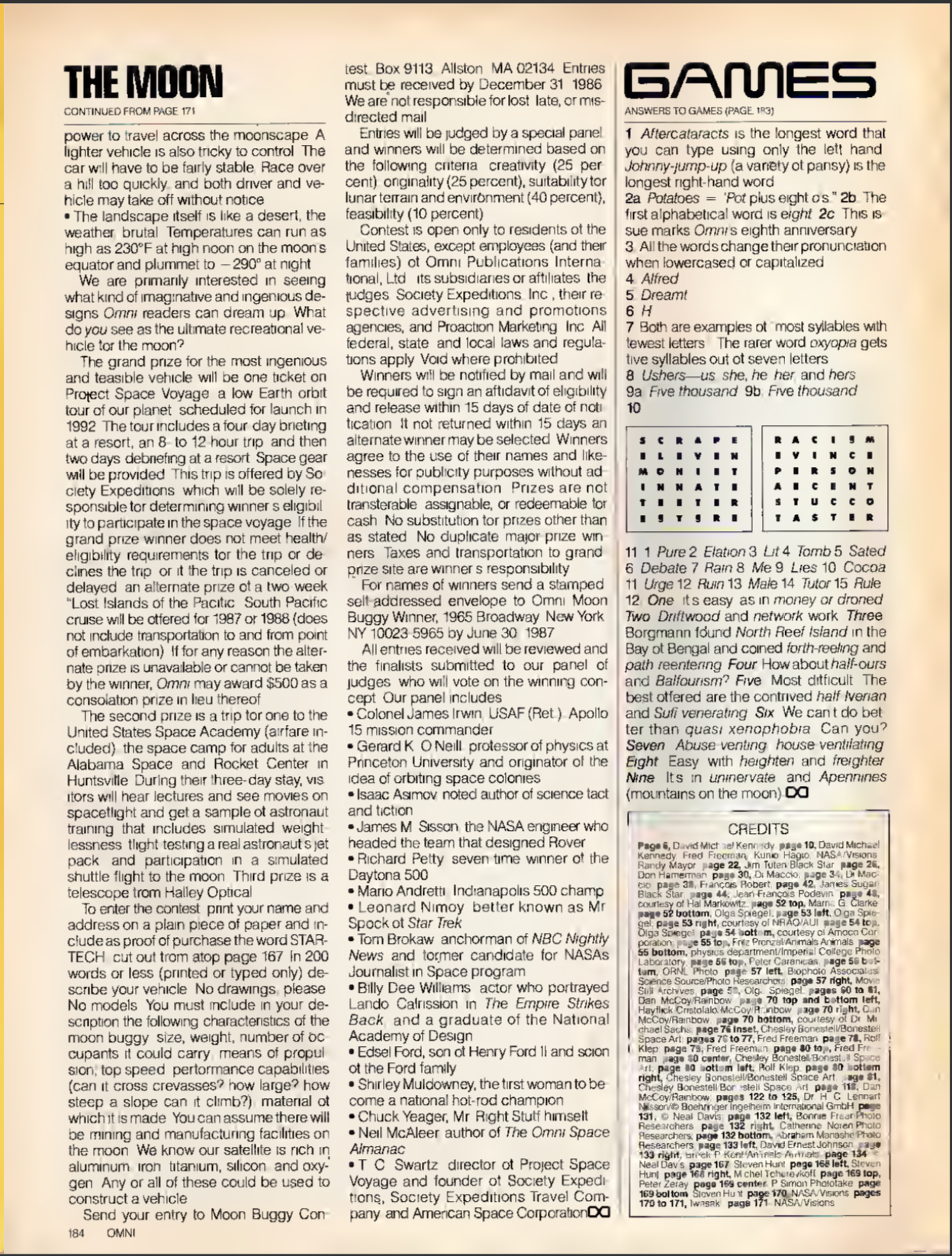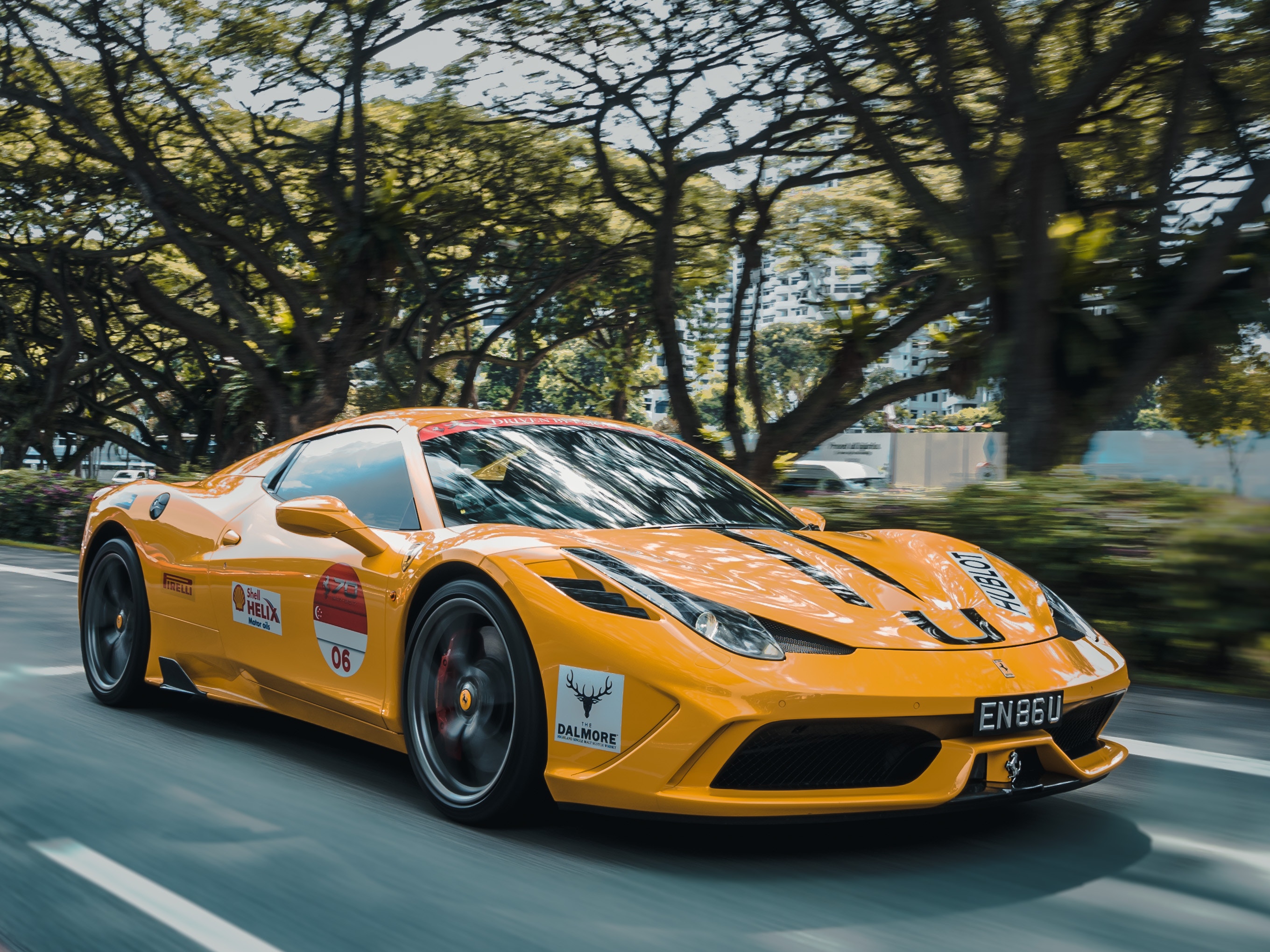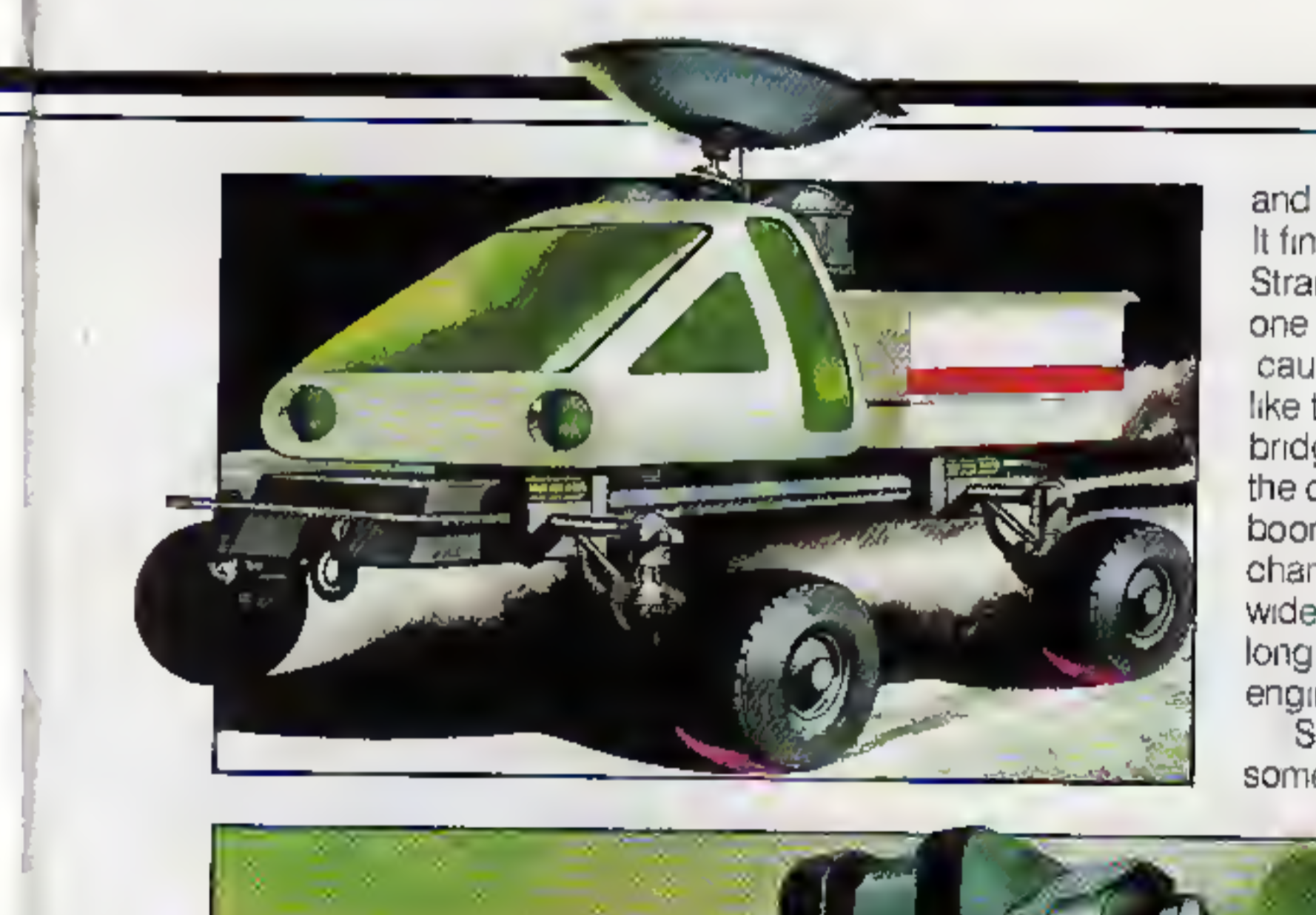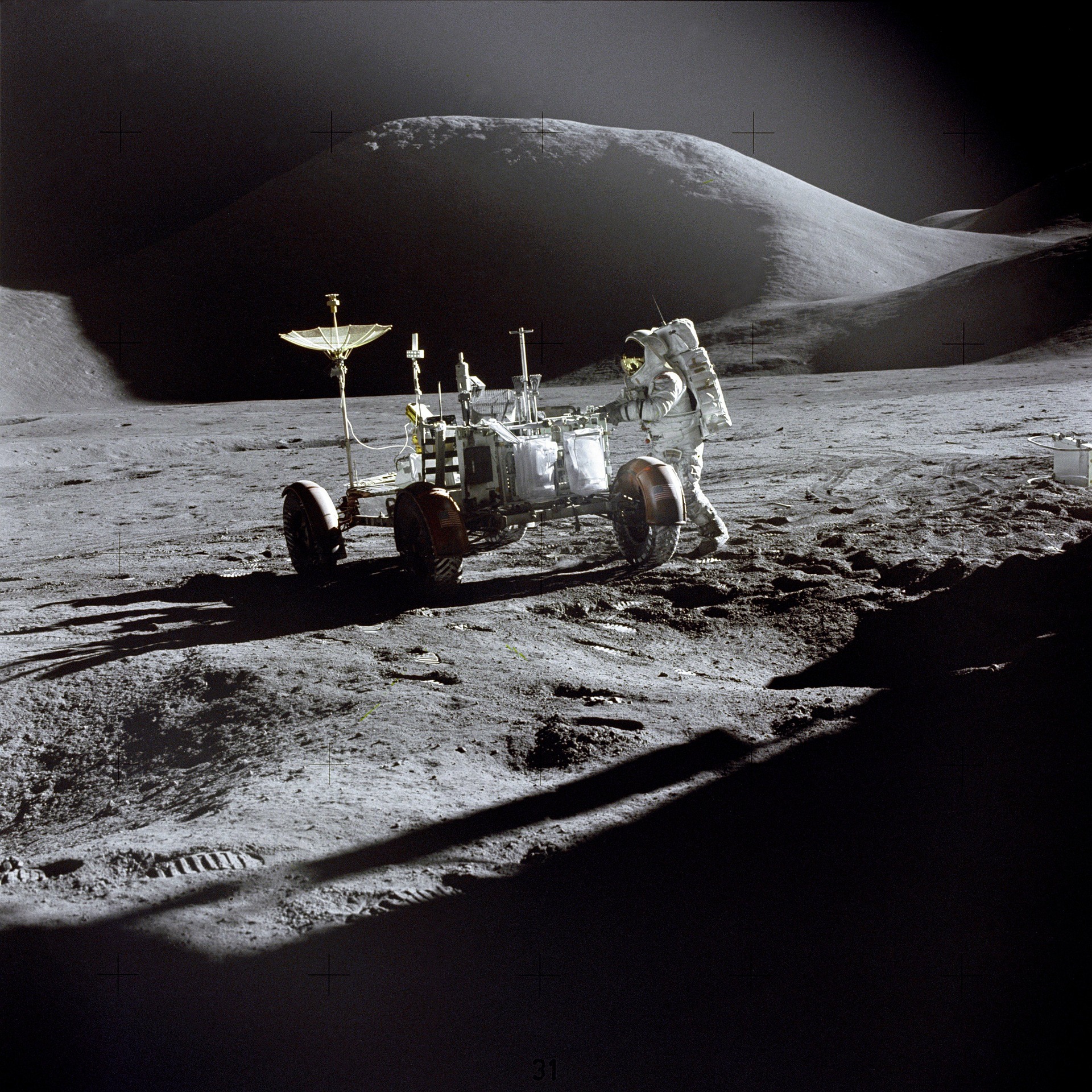Racing Across The Moon: My "Out Of This World" Hotrod Design
"If you're in control, you're not going fast enough."
- Parnelli Jones -
Stop! You'll want to read the beginning of this story first...
With a trip into space at stake,
there was no way I could pass up this Omni contest. And I was in it to win it; I had no intention of losing that prize.
There was little doubt in my mind that I could conceive of a racer that could run circles around pretty much anything else. I fired up some neurons and put my inventor brain to work.
The Racecourse: Six Apollo Sites ~ Image source: Omni Magazine
I knew that my design had to meet the basic Omni instructions quoted in the first installment of this story.
But what would it take to win?
My racer needed to achieve and maintain a high average speed over completely raw, unprepared terrain. Check.
My racer needed foresight, some look-ahead mechanism to scout and map the fine details of the surrounding landscape. Check.
It needed to be able to clear obstacles of various sizes—mostly boulders, modest sized craters, and crevasses—or to map and go around them. Check.
Ideally, the design should be able to traverse slopes up to forty-five degrees steep. Check.
Finally, I needed to be able to compose a comprehensive and comprehensible description of the racer in less than 200 words. Check.
The stakes were high.
An actual trip into space.
My design needed to reach even higher.
The contest instructions... ~ Image source: Omni Magazine
I made sure to follow the contest instructions.
My written description met all the rules.
More importantly, I think my design concept also met my intent to make my racer a superior entry in the lunar marathon. To this day, I believe what you are about to read in less than 200 words below would be a lunar-race-winning champion:
~The Magrod Leaper~
The Omni 2000 Mag-Rod Leaper’s 2x2x1.5 meter cabin jumps two contour-couched pilots across 500 meter wide crevasses and over 100 meter high obstacles. It climbs smooth 45 degree slopes or 65 degree terraced slopes, and travels flat terrain in a series of free-fall arcs interspersed with brief accelerations.
A steerable-angle balancing “ankle” connects a single spiked “foot” to a 10 meter long aluminum-alloy rail “leg.” This capacitive superconducting linear electromagnetic motor projects through a gimbaled mount in the center of the cabin roof.
Silicon cells continuously charge high-density capacitor/batteries. Rapid timed discharges drive the cabin up the “leg,” accelerating the 1500 lb. aluminum and titanium craft to its 100 kph top speed within one second.
A pivoting telescoping “tail” shifts center of gravity / center of thrust, rotating the “leg” into landing position while in flight. Regenerative braking recovers landing energy.
On pilot command, a magnetic catapult launches (and later catches) a rotating terrain-scouting camera which transmits images from altitudes up to two kilometers, providing 3-D topographical computer-enhanced maps.
Triply-redundant distributed optical computers with fiber-optic gyroscopes and IC cantilever beam accelerometers provide autopilot control.
There you have it,
my conceptual design for a race-winning entry, in less than 200 words.
This thing? Not gonna cut it... ~ Image courtesy of Goh Rhy Yan
Can you picture the device I've described?
Not, it doesn't look remotely like the racecar above. That car may be pretty, but it's not gonna cut it on the moon.
Looking back, a mere 200 words is a rather tight constraint for describing the MagRod Leaper. Worse yet, drawings and models were explicitly prohibited by the contest rules. Since the contest long ago, I've had occasion to wonder about the ability of the judges to visualize a design so far from the pale of convention.
But maybe I can pull together a rough 3D model for the final installment of my story. We'll see.
Making things starts in the mind.
All my intuition told me that a conventional, wheeled vehicle would be a tortise in this race. I wanted to design a hare.
The concept I ultimately settled on was like a jackrabbit, or even more a kangaroo. Like Superman of radio thriller and comic book fame, I wanted a machine capable of leaping tall buildings—or boulders—in a single bound.
I did all the math before submitting my entry. Running the numbers, I tweaked the final design to subject the two occupants to a relatively mild 2.8 gravities acceleration for less than two seconds during each half-minute leap.
For comparison, the Goliath roller coaster at Six Flags Magic Mountain is reputed to subject riders to 4.5 times the force of gravity for about six seconds.
The remaining 28 seconds would of course be spent in a free-fall, or zero gravity condition.
Would this become tedious for the riders?
Probably so. However, I believe that the far greater average speed and rough terrain capability would allow for rest periods that would more than compensate for the stress. And, imagine the views from 200 meters above the lunar surface!
Almost looks like a space helmet, right? ~ Image courtesy of Henrik Hjortshøj
But could it really work?
I have little doubt that the hotrod described above could be built. At present, it exists purely in my imagination. I can picture the steps I would take in order to construct it, but the only way to prove the matter would be to actually build and test the MagRod Leaper.
There aren't many lunar slopes steeper than 45 degrees, and they have now been exhaustively mapped, and so I think that the MagRod Leaper would be able to follow a fairly straight course. To the terrain-scouting camera of my original description, I might add a ground-penetrating radar to ensure that we did not land on the thin roof of a lava tube and fall through.
Would you like to go for a MagRod ride with me?
In my imagination, I'm piloting that craft around the Omni magazine lunar race course, and you and I are enjoying the scenery while having some fascinating conversations. Can you dig it? Come on aboard!
What was the outcome of the Omni contest?
Here's a sneak preview of one of the ten finalists in the Omni contest:
Not your father's Oldsmobile... ~ Image source: Omni Magazine
Sorry, but I'm not impressed.
This looks for all the world (or all the Moon?) like a pickup truck with a satellite dish on top. It may offer a more comfortable ride than my MagRod Leaper, but over the rough terrain of the race course, I can't imagine this maintaining an average speed of more than 25kph, can you?
So who won?
In sad but now obvious retrospect, Society Expeditions (the prize company) went out of business, and Project Space Voyage never got off the ground. No tourists went into orbit in 1992. Nonetheless, there was an Omni contest winner.
I'll share the results in my final article.
~To Be Continued~
Note: In order to tell my story, I've included excerpts from Omni under the legal doctrine of fair use, with full attribution to their source.
The Model-T of Lunar Rovers ~ Image courtesy of NASA-Imagery.
Articles In This Series
- Moon Race: The Story of One Crazy Contest
- Racing Across The Moon: My "Out Of This World" Hotrod Design
- Lunar Hot Rod: The Rest of the Story
Important Note: My articles often contain hot links to supplemental information. While they aren't essential, you may find added value by following them. Most images also link to useful or related information or articles.
I want to be a good member of this community, and so I promise to take your comments, both positive and corrective, very seriously.
I'm especially interesting in meeting makers. If you make stuff, I would love to read about it and encourage you in any way that I can... Just say "Hi" in a comment, and show me what you're working on; I welcome your links!
Thanks to @beherenow for this lovely #thebeast banner!
Your opinion is celebrated and welcomed, not banned or censored!


